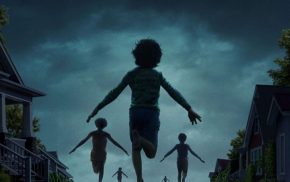“Where The Tracks End” is a delightful Mexican movie that captures the essence of childhood wonder and adventure while addressing important social issues. Directed by Ernesto Contreras [Párpados Azules], the film takes heavy inspiration from the works of Jules Verne, resulting in an authentically Mexican story of adventure with a touch of fairy tale magic.
At the heart of “Where The Tracks End” is the story of Ikal and his working-class family. Living in wagons and constantly traveling from one dusty village to another, they represent the resilience and strength of many Mexican families who lead a nomadic lifestyle. Despite their poverty, their true wealth lies in their peace, love, and harmony at home. The film admirably showcases the value of a healthy family dynamic amidst challenging circumstances and dangerous work. We, as viewers from First World countries, should take these families as examples.
Ikal navigates the challenges of school, first love, and the first brutal strokes of reality. The film captures the spirit of youthful innocence and brings back memories of the carefree days of childhood. A traveling circus brings a touch of mysticism, featuring wizards, rabbits in hats, and fearless acrobats to the Mexican countryside. In many ways, “Where The Tracks End” harks back to the beloved children’s movies of the 90s, like “The Little Princess,” “Jumanji,” and “Pee Wee’s Big Adventure.”
The film’s cinematography [dp: Juan Pablo Ramírez] is nothing short of beautiful, capturing the essence of the Mexican countryside with its sweeping landscapes and vibrant colors. People’s close connection to nature is a significant focus throughout the movie, emphasizing the importance of respecting the environment and living in harmony with it. Complementing the stunning visuals is a soothing and playful soundtrack by Gus Reyes and Andrés Sánchez that enhances the story.
Besides the personal storylines, the film also presents a compelling social backdrop. The desire for a better life and dreams of reaching the USA permeate the conversations among the children in the village. The filmmakers effectively depict the societal inequality and the stark reality that many families face. The closing of small, local schools as part of a government plan for education modernization adds depth to the narrative, emphasizing the importance of education in shaping a nation’s future.
The standout performance by the young lead actor, Kaarlo Isaac, brings Ikal’s character to life with nuance and sensitivity. Through the parallel storyline of teacher Georgina, played by Adriana Barraza, the film highlights the transformative power of education. The relationship between Georgina and Ikal becomes the heart of the plot, showcasing the miracles that inspiring teachers can perform in the lives of their students. In one of the most heartwarming scenes, Ikal tells teacher Georgina that he dreams of becoming a teacher himself.
Contreras’s love for symbolism is evident throughout the movie, there is a strong connection between railroads and the journey of growing up, the railroads and Mexican reality. In this day and age, there is definitely a great need for more kid-friendly movies like this that can educate, uplift and marvel children and grown-ups alike.
„Where The Tracks End” streams on Netflix.
~ by Dora Endre ~



























Comments
1 Responses to “„Where The Tracks End” Review: Clouds Taste Like Cotton Candy”